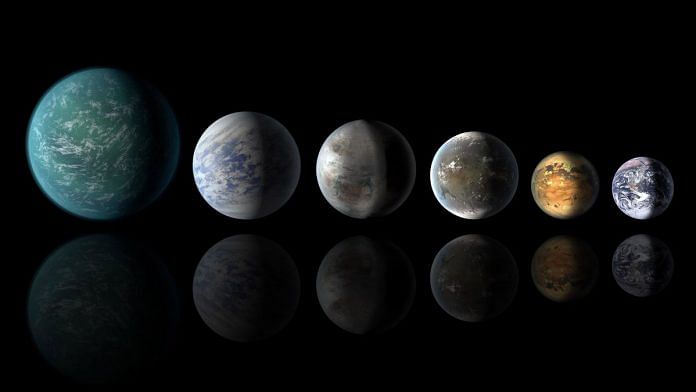New Delhi: Santamasa and Bibha are the names India has chosen for an exoplanet and its host star located 340 light years away from Earth.
As part of the Paris-based International Astronomical Union’s centenary celebrations, over 110 countries were given an opportunity to name one planetary system comprising an exoplanet and its host star. Over 780,000 people worldwide participated in the naming of these planetary systems. The names of these 110 sets of exoplanets were announced at a press conference in Paris Tuesday.
Santamasa in Sanskrit means clouded, which alludes to the exoplanet’s atmosphere, while Bibha is the Bengali pronunciation of the Sanskrit word vivha, which means a beam of light and also honours late Indian physicist Dr Bibha Chowdhuri, who worked in the field of particle physics and cosmic rays.
Also read: Water vapour discovered on exoplanet 110 light years away
The ASI contest
The Astronomical Society of India (ASI) had announced a contest for school and college students earlier this year, asking them to send suggestions to name the exoplanet assigned to India. The ASI had received more than 1,700 suggestions, out of which five were shortlisted. Over 5,500 people voted in the final round.
Ananyo Bhattacharya, a 20-year-old student from Sardar Vallabhbhai National Institute of Technology in Surat, gave the name for the star while Vidyasagar Daud, a 13-year-old student from Singhad Spring Dale Public School in Pune, proposed the planet’s name.
The planetary system with the star HD 86081 had been assigned to India. The star is slightly hotter, larger and older than the Sun and has a surface temperature of 6028 K — giving it a yellowish colour.
The star is located in the constellation of Sextans and is easily visible in the night sky through binoculars and small telescopes.
The planet, HD 86081 b, orbiting this star appears to be similar to Jupiter in size and mass. This planet is expected to have an extremely high temperature as it orbits very close to its star and is visible in Indian skies.
Dr. Somak Raychaudhury, director of Inter-University Centre for Astronomy and Astrophysics and member of the national committee said this election procedure has come up with the best name possible.
“Apart from the literal meaning of the word, which is appropriate, the star’s name refers to the pioneering Indian woman scientist Dr Bibha Chowdhury. She discovered a new subatomic particle, the pi-meson, from experiments in Darjeeling, with her mentor D.M. Bose, and published her results in Nature, but did not get due recognition. I am very happy that we can recognise her contribution by naming a unique cosmic body after her.”
Also read: NASA telescope finds exoplanet trio that can unravel mysteries of planet formation
The other exoplanets’ names
This is only the second time in history that a campaign has been launched to name stars and exoplanets, the IAU said in a statement.
“Astronomical observations over the past generation have now discovered over 4,000 planets orbiting other stars — called exoplanets,” said Eric Mamajek, co-chair of the NameExoWorlds Steering Committee.
“The number of discoveries continues to double about every two and half years, revealing remarkable new planet populations and putting our own Earth and Solar System in perspective”, said Mamajek.
“While astronomers catalogue their new discoveries using telephone-number-like designations, there has been growing interest among astronomers and the public alike in also assigning proper names, as is done for Solar System bodies,” he added.
Ireland named its assigned planet and star after mythological dogs Bran and Tuiren, while Jordan selected names of ancient cities and protected areas in southern Jordan, Wadirum for the planet and Petra for its host star.
Malaysia selected names of gemstones in Malay language for the exoplanet HD 20868 b (Baiduri) and orbiting the star HD 20868 (Intan).
In recognition of the UN 2019 International Year of Indigenous Languages, speakers of indigenous languages were encouraged to propose names from those languages, and a few dozen of the selected names are of indigenous etymology.
In Argentina, a teacher and community leader from the indigenous Moqoit community submitted the winning proposal. The new names for the planet HD 48265 b (Naqaya) and star HD 48265 (Nosaxa) mean “brother-family-relative” (referring to all human beings as “brothers”) and spring (literally, new year), respectively, in the Moqoit language.
India too had extended its deadline for submitting names when ASI found that students were not sending ‘Indian’ suggestions.
These names are the officially accepted names, but will not replace the official designations. They will be used alongside the assigned designations in scientific literature.






